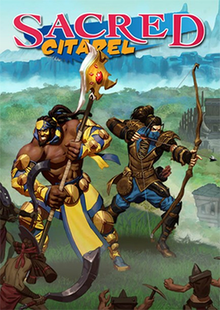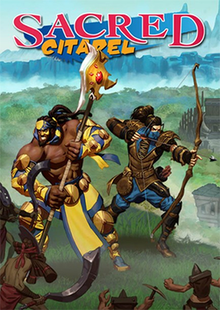Existing User Log In
New User Registration
Register for a free account to gain full access to the VGChartz Network and join our thriving community.





America - Front


America - Back

Southend Interactive
Action
 (Add Date)
(Add Date) (Add Date)
(Add Date) (Add Date)
(Add Date)
| Owners: | 0 |
| Favorite: | 0 |
| Tracked: | 0 |
| Wishlist: | 0 |
| Now Playing: | 0 |
There was a time when dungeon-crawling Diablo clones rampantly made their way through the PC and console market. Baldur's Gate: Dark Alliance and Champions of Norrath saw some great success on consoles, while games like FATE, Titan's Quest, and Sacred serviced the PC community. Yet, the attack of the clones has remained in a state of limbo, especially with the third iteration of papa Diablo coming and going through a debacle of auction house woes, even if Torchlight and its fantastic sequel were there to pick up the slack.
These clones did not disappear, however, they just simply moved to a new genre of sorts - the side-scrolling beat-'em-up. Castle Crashers proved to be wildly popular across multiple platforms, combining side-scrolling with some basic RPG aspects, and others followed suit, including a couple of free-to-play gems like Rusty Hearts and Dungeon Fighter Online, with DFO subsequently making the jump to Xbox Live. Not wanting to miss another opportunity for cloning, the Sacred series climbs aboard with Sacred Citadel, the prequel to the yet-to-be-released Sacred 3. I can't really say that I was brimming with excitement with its announcement, but when it was revealed that Swedish ilomilo developer SouthEnd Interactive was behind it, my interests were peaked. It's just too bad that this appeal isn't lasting.
If you have any familiarity with the mythos of Sacred, you're aware that while the premise and backstory has some exciting allure to it, its execution quirkily fumbles along. After an eon of peace, the protectors of the Ancaria realm, the Seraphim, have lived quiet lives void of conflict, with most forgetting their training and purpose, while the rest of the realm struggle to remember they existed. However, an evil emperor, Lord Zane of the Ashen Empire, has discovered how to usher in the return of the Gatekeeper, a being able to confront the strength of the Seraphim and conquer all of Ancaria, and only a select few heroes can hope to protect the realm against it.
Sacred Citadel is the prequel and companion to the upcoming Sacred 3, ushering in the backstory of the third iteration of the main series, and it does this quite superbly. I'm genuinely interested in uncovering the secrets of Lord Zane, the Ashen Empire, and the origins of the demonic Gatekeeper, yet this is partly due to the poor storytelling that discharges forth. Marred by a spastic, bare narrative that sees no real culmination of events in its abrupt finish, greatly unsuccessful attempts at humor, and voice acting that is at best mediocre and at worst simply embarrassing, I'm more intrigued how Deep Silver will make any sense of this mess of plot in terms of Sacred 3. It's hard to become enraptured with the narrative that Sacred Citadel offers, and the rare occasions that some narrative gold makes its way through the muck, it's not nearly enough to warrant paying attention to.
But where the story falters, the hack and slash side-scrolling gameplay picks Sacred Citadel up by its bootstraps and trudges forwards. Four playable characters are available to be selected, but like its copied formula of Castle Crashers, the difference between each resides in the character's ability. The Safiri Warrior, Khukuri Shaman, Seraphim Mage, and Ancarian Ranger all dual wield a variety of swords, axes, and maces, as well has having a specific ranged attack and unique character ability. Fighting the hordes of Grimmocs will take much hacking and slashing across the game's four acts, with new combos of simple four or five button inputs granted every couple of levels earned. Each character's ranged weapon provides different advantages, with the Seraphim Mage throwing out an area of effect explosive blast of fire and the Ancarian Ranger pelting orcs with rapid firing bows; all in all it keeps the action somewhat varied. Character abilities, powered by the focus meter and limited to just one type, are quite useful when confronted with a large group of enemies or one of the more difficult bosses, and are the only real defining aspect of Citadel’s combat . While the initial reaction to the combo system will be favorable, once the honeymoon phase is over, the game’s deficiencies are apparent.
Repetition, like many hack and slash games, becomes the major focus of combat, and subsequently, the major problem with gameplay. Though changing characters will provide new ranged and special attacks, basic combinations and the bulk of combat plays the same for each character, which can get very boring. Even with the more advanced combos gained at certain levels, the most useful combinations break down to just two moves by pounding away on the X button, with a stray Y thrown in at the end. Weapons are also granted different elemental powers, but elemental effectiveness is based upon a certain stat, and is only useful if the stat has been built up considerably, as damage output is more reliant on physical damage than elemental. It gets rather old rather quickly, and is exacerbated by the ease of combat and broken mechanics. It's extremely easy to get almost every enemy trapped in the corner indefinitely, with the normal split-second rest time between combinations and ranged attacks eliminated due to the enemy being up against the invisible wall. Certain bosses can fall victim to this cheesy cornering, which takes away the only challenge Sacred Citadel had to offer. Even without the glitchiness, the game is entirely too easy, and can be completed rather effortlessly all alone without so much as a continue used. Though having the ability for both online and couch co-op of up to three people is always a nice touch, here it hinders the experience due to the game becoming an absolute cakewalk.
Like its genre brethren, loot is readily available for collection and stat points can be allocated each level, yet Sacred Citadel makes some improvements on both. With two main weapons, a ranged option, and armor to equip, there’s a considerable amount of unique loot to find with the standard elements attached, ranging atypically from fire to ice to lightning. Main weapon loot is shared in multiplayer where any player can pick up a sword, axe or mace, but the ranged weaponry is character specific and can only be picked up by a certain character. Like all loot-fueled dungeon crawlers, the best equipment can be found from more powerful monsters and bosses. However, the tiers of loot that are common for the dungeon crawling genre are not utilized, with the best weapons and armor simply providing the highest damage output or armor score. The loot system simply does its job, nothing more, nothing less, and certainly offers no surprises, like legendary weapons or set-based equipment. The basic RPG elements are there, but the loot varies very little; just enough to fuel the mindless hacking and slashing, instead of something a bit more robust.
Customizing each character is definitely one of Sacred Citadel's strong points, even though there are only four basic attributes to spend skill points in after gaining a level. Strengthening combatants can be done through attack, defense, dexterity, and power that give bonuses to melee and character ability damage, damage received, ranged damage, and elemental damage, respectively. While defense is meaningless given the lack of difficulty, raising the other three stats provide some usefulness. Power is the most interesting of the four, as it gives the elemental weapons some more staying power, eventually allowing for enemies to be frozen or paralyzed with electricity. The only downfall to the leveling system shows itself with a relatively low level cap at 40, which barely grants enough skill points to max out one category.
Another bright spot that helps with the monotonous combat is the lively art style. Following suit with the Sacred series, Citadel sees some typical, yet vibrantly colorful and well designed environments, as well as some wonderfully detailed character and enemy models. Every act has a specific habitat attributed to it, with lush forests, magnificent volcanos, gloomy caves, arctic tundras and impregnable castles, with each more impressive than the last. Each character has their own unique style from their respective race or clan, though all exhibit striking colors that complement their flashy character powers. While the enemies may not be varied much, they do look rather majestic as they get repeatedly pummelled for four acts. Also making some (sound)waves is the surprisingly good music. Each act has themed music that fits each environment, and even the menu music is mesmerizing. I found myself just putting the controller down for 10 minutes before I launched a game, sitting back and enjoying the superb groove the game creates.
Is Sacred Citadel a bad game? By no means. However, with its repetitive and glitchy combat, small level cap, patchy narrative, lack of difficulty, and a playtime that clocks in at less than 5 hours, it's hard to recommend. There is fun to be had, especially if you're one for dungeon expeditions and loot gathering, it's just going to take some willpower to deal with the shortcomings. Hopefully Sacred 3 will be able to pick up the pieces.
This review is based on a digital copy of Sacred Citadel for X360 provided by the publisher.









